 |
| September 07, 2021 | Volume 17 Issue 33 |
Designfax weekly eMagazine
Archives
Partners
Manufacturing Center
Product Spotlight
Modern Applications News
Metalworking Ideas For
Today's Job Shops
Tooling and Production
Strategies for large
metalworking plants
50 years ago: Apollo 15 first lunar rover drive and the Genesis Rock
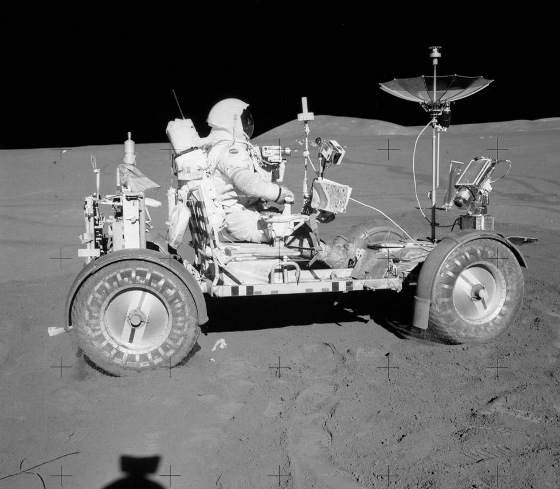
Apollo 15 Astronaut David R. Scott maneuvering the Lunar Roving Vehicle at the start of the second lunar traverse, with the Solar Wind Collector visible beyond the Rover TV camera. [All images courtesy: NASA]
By John Uri, NASA Johnson Space Center
The fourth Moon landing mission began on July 26, 1971, with the launch of Apollo 15. Apollo 15 entered lunar orbit on July 29, 1971. The next day, astronauts David R. Scott and James B. Irwin separated their Lunar Module (LM) Falcon from Alfred M. Worden, who remained in orbit aboard the Command Module (CM) Endeavour.
Scott and Irwin touched down at the Hadley-Apennine site and conducted four spacewalks, including three excursions using the Lunar Roving Vehicle, for a combined total of 19 hours. They deployed an experiment package and collected 170 pounds of rock and soil samples to return to waiting scientists on Earth. In the meantime, Worden conducted an expanded set of observations and photography of the lunar surface from orbit. After their 67-hour lunar surface stay, Scott and Irwin prepared to rejoin Worden in orbit.
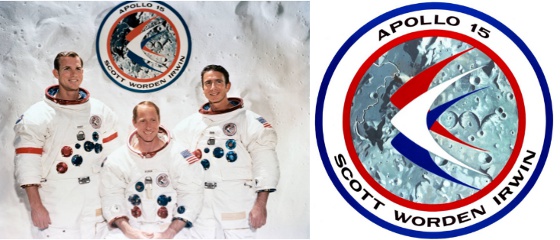
Left: The Apollo 15 crew of (left to right) David R. Scott, Alfred M. Worden, and James B. Irwin. Right: The Apollo 15 crew patch.
Following the July 26, 1971 launch from NASA's Kennedy Space Center in Florida, Apollo 15's translunar coast lasted 78 hours. During the astronauts' fourth day in space, their spacecraft's trajectory took them past the leading edge of the Moon, and as they disappeared behind it, as expected, all contact with the Mission Control Center (MCC) at the Manned Spacecraft Center, now NASA's Johnson Space Center in Houston, was cut off.
Thirty minutes later, the Service Propulsion System (SPS) engine fired for 6 minutes, 38 seconds to drop them into an elliptical 194-by-68 mile lunar orbit. As they reappeared from behind the Moon, Scott radioed to Houston, "Hello, Houston, the Endeavour's on station with cargo, and what a fantastic sight." From the MCC, capsule communicator (capcom) Karl G. Henize responded, "Beautiful news. Romantic, isn't it?" prompting Scott to add, "Oh, this is really profound; I'll tell you, fantastic!"
During their first orbit, the astronauts excitedly provided a running commentary as they passed over the lunar landscape, flying over their landing site, still obscured in the pre-dawn darkness. Henize reported that the cameras and other experiments in the Service Module's Scientific Instrument Module (SIM) bay all worked properly.
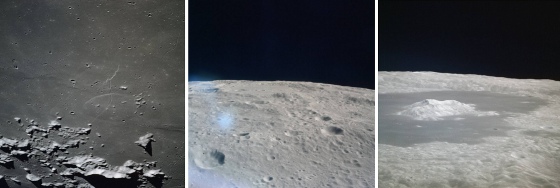
Left: Image of the Mare Serenitatis on lunar nearside. Middle: Rugged terrain on lunar farside. Right: The central peak of the large farside Tsiolkovsky crater is clearly visible.
At the beginning of their third revolution, once again behind the Moon, the astronauts fired the SPS engine for 25 seconds to drop the high point of their orbit from 194 miles to 11 miles. The maneuver saved propellent in the LM as it began its descent from a low altitude. As they came out from behind the Moon, Scott reported, "Hello, Houston, Apollo 15. The Falcon is on its perch," indicating that the LM was in the proper orbit to begin its descent. During their fourth revolution, the astronauts ate their first dinner in lunar orbit. Then, as they rounded to the far side, the crew began its first sleep period around the Moon.
Scott, Worden, and Irwin slept soundly until the eighth revolution. The astronauts treated viewers on Earth to a 15-minute TV broadcast, pointing out the landmarks as the spacecraft flew over them. Back on Earth, Scott's wife Lurton, his mother Marian, and Irwin's wife Mary Ellen were accompanied by Apollo 11 astronaut Neil A. Armstrong as they watched the show from the MCC Visitor Gallery.
Overnight, the Moon's uneven gravity caused the low point of their orbit to drop to 8.7 miles, requiring a 19-second burn of the SPS engine to raise it back up to the more desirable 11 miles. While the astronauts executed the maneuver, in Mission Control, Flight Director Glynn S. Lunney and his Black Team of controllers took up their positions at the consoles, with Apollo 14 astronaut Edgar D. Mitchell as the new capcom. After they rounded to the Moon's nearside on their 10th revolution, the astronauts viewed their landing site for the first time as the Sun had now risen over the Hadley-Apennine area.
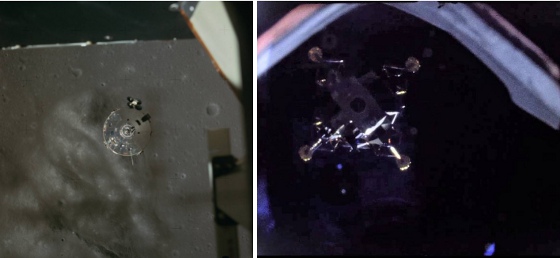
Left: The Apollo 15 Command Module Endeavour shortly after separation in lunar orbit. Right: The Apollo 15 Lunar Module Falcon shortly after separation in lunar orbit.
On their next revolution, Scott and Irwin donned their spacesuits and entered and activated the LM Falcon, leaving Worden in the CM Endeavour. The crews closed the hatches between the spacecraft and prepared for undocking at the start of the 12th orbit. As Scott and Irwin prepared for the descent and landing, Worden fired the SPS engine for 4 seconds to circularize the CM's orbit to 69 miles. On revolution 13, both spacecraft reappeared from behind the Moon and observed and photographed the Hadley-Apennine landing site.
At the beginning of the next revolution, Falcon received the "Go" from capcom Mitchell in Mission Control to begin the powered descent to the surface. The LM's descent-stage engine ignited, at 10% thrust for the first 26 seconds before throttling up to full thrust to take them out of orbit and toward the surface. Scott and Irwin flew a trajectory steeper than their predecessors to clear the 12,000-foot ridge of the Apennine mountains that stood in front of their landing site. At the beginning of the descent, the spacecraft's attitude had the crew essentially on their backs flying feet first.
At an altitude of about 6,000 feet, the LM began the pitch-over maneuver and, for the first time, Scott and Irwin saw their landing site ahead, with Hadley Rille clearly visible and Mount Hadley looming several hundred feet above them on their left. At 400 feet, Scott took over manual control of the LM, while Irwin called out altitude and descent rates. The first evidence of dust kicked up by the Falcon's engine occurred at about 120 feet. By 50 feet above the lunar surface, dust obscured their view. Flying the last few feet by instruments alone, Scott and Irwin touched down on the Moon and Scott called to Mission Control, "Okay, Houston. The Falcon is on the Plain at Hadley."
After a quick check of the LM's systems, Mission Control gave Scott and Irwin the "Go" to stay on the surface. Falcon landed with its rear landing leg inside a shallow crater, the vehicle tilted backwards 6.9 degrees and to the left 8.6 degrees, well within the acceptable range for a successful liftoff. Following a change of shift in Mission Control, with Flight Director Milton L. Windler's Maroon Team and astronaut Joseph P. Allen as capcom assuming their console positions, the two astronauts prepared for the first major activity on the surface, Scott's stand-up spacewalk.
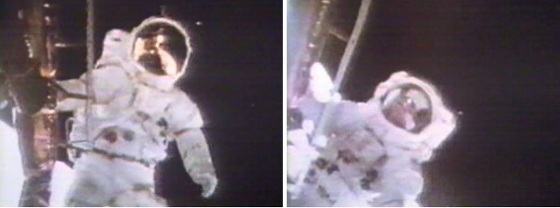
Left: Apollo 15 astronaut David R. Scott first sets foot on the Moon at Hadley. Right: Astronaut James B. Irwin joins him 8 minutes later.
About two hours after landing, Scott and Irwin depressurized the LM and opened the overhead hatch. Scott stood up on the ascent engine cover with his head and shoulders through the hatch, surveying their landing site. From his higher vantage point, about 23 feet above the surface, Scott took a series of photographs as he panned around to generate a 360-degree view of the landing site and provided a running commentary for the geologists in the Mission Control Science Support Room. Scott climbed back down and he and Irwin repressurized the LM, ending the 33-minute stand-up spacewalk.
For the first time on the Moon, the astronauts removed their suits in preparation for their first night's sleep. Program managers felt that with the longer stay and the experience of previous missions, removing the suits for the astronauts' comfort outweighed any safety risks. Scott and Irwin went to sleep in their hammocks.
Both Scott and Irwin slept well their first night on the Moon, although Mission Control needed to awaken them about an hour early to deal with a potential oxygen leak that the astronauts fixed by closing a valve. Once that was resolved, they moved into preparing for the first of their three Moon walks, with capcom Allen back on console to assist them. Scott and Irwin put on their spacesuits, depressurized the LM, and Scott opened the hatch and backed out onto the LM's porch. He pulled a lanyard that deployed a color TV camera so viewers could see him coming down the ladder.
Scott jumped down to the footpad and then onto the lunar surface itself, saying, "As I stand out here in the wonders of the unknown at Hadley, I sort of realize there's a fundamental truth to our nature. Man must explore. And this is exploration at its greatest." Irwin joined him on the surface 8 minutes later and collected the contingency sample.
They next deployed the Lunar Roving Vehicle (LRV), or Rover, and Scott took it for a brief test drive, becoming the first human to drive on the Moon. They loaded up the electric-powered Rover with the equipment required for the first traverse, including putting the TV camera on the vehicle that Edward I. "Ed" Fendell operated remotely from Mission Control to keep up with the astronauts' activities.
Scott and Irwin set off toward their first stop, heading south-southeast along Hadley Rille toward Elbow Crater, 3.2 kilometers away. All along the drive, both astronauts provided a running commentary of the geologic features they observed. They parked the Rover at Elbow Crater and pointed the high-gain antenna toward Earth to allow a continuation of the TV transmission.
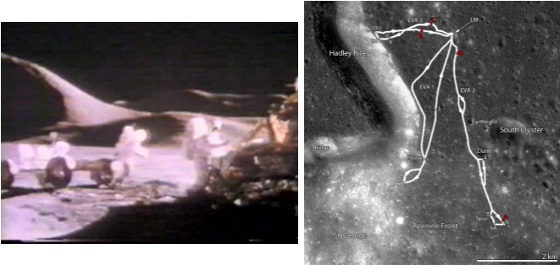
Left: Still image from TV downlink of James B. Irwin, left, and David R. Scott loading the Rover for the first excursion. Right: The three Apollo 15 traverses overlaid on a Lunar Reconnaissance Orbiter photograph of the landing site.
After collecting geology samples, they boarded the Rover for the short drive southeast to Station 2 near St. George Crater on the slopes of Mt. Hadley. Scott took samples from a boulder and Irwin took a double core sample from the crater rim. Getting back on the Rover, they drove down the slope and back north to the LM, omitting a planned Station 3 stop because they were running behind on the timeline.
VIDEO: Spacecraft with wheels: The Lunar Roving Vehicle (archival film) [Credit: NASA's Marshall Space Flight Center]
They parked near Falcon to load the Rover with some of the Apollo Lunar Surface Experiment Package (ALSEP) instruments. Scott drove to select a deployment site about 360 feet west-northwest of the LM while Irwin carried the remaining instruments. The two teamed up to deploy the ALSEP experiments. Scott had difficulty drilling the holes required for the heat-flow experiment due to a harder subsurface than expected, so Mission Control told him to move to the next task and come back and finish the drilling during the second Moon walk.
They then drove back to the LM, where Scott deployed the Solar Wind Collector (SWC) experiment. After dusting each other off, they carried the samples collected during this excursion back into the LM and closed the hatch. The first Apollo 15 Moon walk lasted a then-record-setting 6 hours and 34 minutes. After a well-earned dinner and a debrief with Mission Control, Scott and Irwin settled down for their second night on the Moon.

Left: Apollo 15 astronaut David R. Scott standing next to the Rover at Station 1 near Elbow Crater during the first lunar traverse. Middle: Photo taken from Station 2 during the first traverse giving a view of the Swann Range, named for geologist Gordon Swann, and showing the Rover's tracks at the far right. Right: Near the end of the first Moon walk, Irwin works near the Rover with 13,000-foot-high Mt. Hadley in the background, 12 miles away.
The next morning, Scott and Irwin suited up once again, depressurized Falcon, and descended to the lunar surface. Less than an hour later, having checked out and loaded the Rover, they began their second lunar traverse heading south from the LM along the Front -- the northern flank of Mt. Hadley -- to Station 6. They parked the Rover on an 11-degree slope about 5 km from Falcon, the furthest any astronauts had traveled from their spacecraft up to that time.
Scott took photographs using a 500-mm telephoto lens of Falcon as a small object in the distance, dwarfed by the scenery. After collecting numerous rock and soil samples, including a core sample, they packed up the Rover and headed west to sample a large, partially embedded, greenish boulder at Station 6a. Because of the 15-degree slope, Irwin held the Rover steady while Scott sampled the boulder.
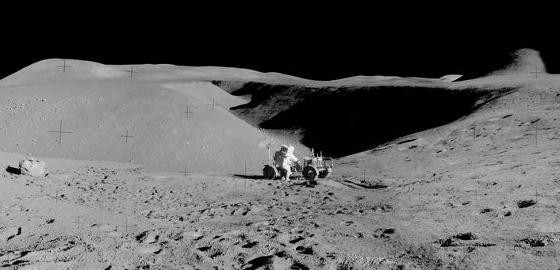
Composite panoramic image of David R. Scott working at the Lunar Roving Vehicle near Hadley Rille during the first Apollo 15 lunar excursion.
Next, they drove to Station 7 at Spur Crater where they found, among other numerous samples, a white crystalline rock later dubbed the Genesis Rock. On the way back to the LM, they made a quick stop at Dune Crater (Station 4) to sample a large vesicular boulder. From there they drove the 3.4 km back to the LM, setting a lunar land speed record of 12 km/h.
Back at Falcon, they unloaded the collected samples from the Rover. Irwin stayed near the LM to take photographs and unstow the American flag, while Scott continued to finish the drill work for the heat-flow experiment at the ALSEP site. Irwin walked out to the ALSEP site to conduct a soil mechanics experiment by digging a trench, and Scott collected a core sample using the drill. They returned to the LM, Irwin walking and Scott driving the Rover, where they deployed the American flag. Once again, they carried their collected samples as they reentered the LM, repressurizing Falcon after being outside for 7 hours and 12 minutes, beating their previous record. Following a quick debrief with Mission Control and dinner, they settled down for their third night's sleep on the Moon.

Left: During the second Moon walk, James B. Irwin holding the Rover steady at Station 6a, behind a greenish boulder sampled by the crew. Middle: David R. Scott at Station 7 aiming the Rover's high-gain antenna to Earth to enable the TV transmission. Right: The so-called Genesis Rock at Station 7 before collection.
After a good night's sleep, Scott and Irwin ate a quick breakfast and suited up for their third and final lunar traverse, the drive west to Hadley Rille. After depressurizing the LM, they descended to the surface and loaded up the Rover with their needed equipment. Scott and Irwin took color photographs of each other saluting the American flag, and then Scott drove out to the ALSEP site while Irwin walked. Once there, and with great effort, they collected the core sample drilled the day before.
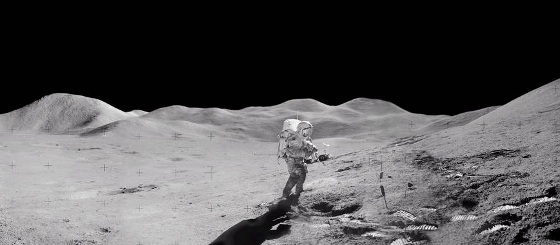
Composite panoramic image during the second Moon walk showing the steep 11-degree angle on the slope of Mt. Hadley. The Rover is visible behind David R. Scott.
They set off west toward the rille, stopping at Station 9 for photography and sample collection near a 15-meter-diameter crater. After that brief stop, they continued due west to Station 9a on the rim of Hadley Rille to photograph the west side of the canyon and take core and other samples. They drove a short way northwest along the rim of the rille to Station 10 for some more photography of the canyon's west wall. From there, they drove the 2.5 km back to the LM, picking up the drill core sample at the ALSEP site on the way.
Back at the LM, they photographed and rolled up the Solar Wind Collector experiment for return to Earth. As they continued packing their samples and film cartridges for return to the LM, Scott provided a physics demonstration for the TV audience back on Earth.
"Well, in my left hand, I have a feather; in my right hand, a hammer. And I guess one of the reasons we got here today was because of a gentleman named Galileo, a long time ago, who made a rather significant discovery about falling objects in gravity fields. And we thought where would be a better place to confirm his findings than on the Moon. And so we thought we'd try it here for you. The feather happens to be, appropriately, a falcon feather for our Falcon. And I'll drop the two of them here and, hopefully, they'll hit the ground at the same time." As the hammer and feather hit the lunar dust at the same time, Scott said, "How about that! Which proves that Mr. Galileo was correct in his findings."
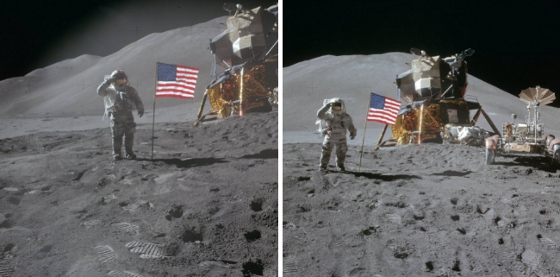
Apollo 15 astronauts David R. Scott, left, and James B. Irwin salute the American flag.
Not mentioned publicly until the crew's postflight press conference, Scott left a memorial plaque and a statuette on the lunar surface dedicated to astronauts and cosmonauts lost in the line of duty. Scott then parked the Rover about 500 feet away from the LM, in a position that the TV camera could broadcast their liftoff a few hours later. After brushing each other off one last time, Scott and Irwin climbed back up the ladder and into the LM. They repressurized Falcon after spending 4 hours and 50 minutes outside.
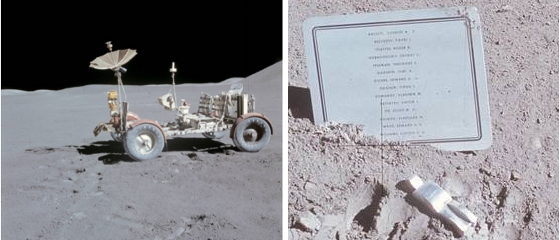
Left: The Rover's final parked position at the end of the third lunar excursion. Right: Image of a plaque and a statuette left on the Moon to commemorate fallen astronauts and cosmonauts.
Flight Director Gerald D. "Gerry" Griffin congratulated Scott and Irwin on their performance on the lunar surface, saying, "The whole Mission Control team wants to take their hats off to you for a fine job. It was a lot of fun." Scott replied, "Well, thank you, Gerry. We'd like to take our hats off to the whole team. By golly, you guys are really sharp down there, and we sure appreciate it. 'Cause you know as well as we do we sure couldn't do it without you." Scott and Irwin busied themselves with preparations for liftoff, just three hours later.
Learn more about NASA's Apollo 15 mission at nasa.gov/mission_pages/apollo/apollo-15. A big thanks to NASA and author John Uri for penning such interesting and detailed accounts for all of us to read, learn from, and enjoy.
Published September 2021
Rate this article
View our terms of use and privacy policy
